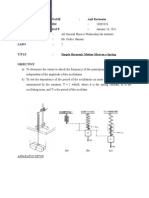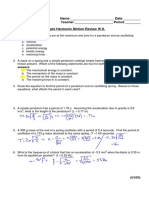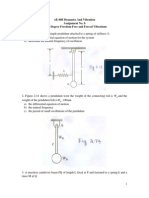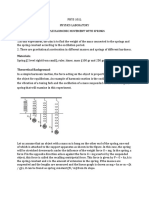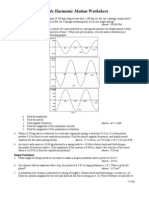Simple Harmonic Oscillator
Review the Textbook on Hook's Law (Spring Force), and Vibrations (Simple Harmonic Motion).
• Phys 1402: Serway/Vuille: Sections. 13.1, 13.3, 13.4
• Phys 2426: Serway/Jewett: Sections 7.4, 15.1, 15.2
1. A spring of a kitchen scale stretches 6.2 cm from un-stretched position (equilibrium) when a bunch of
bananas is suspended from it. What is the mass of the bananas if the spring constant of the kitchen scale
is 126 N/m?
(800 g)
2. A position of a simple harmonic oscillator as a function of time is presented on the graph below.
Determine the amplitude, the period, and the frequency of the oscillation from the graph.
(amplitude = 1 m; T = 2 s; f = 0.5 Hz)
Figure 1. Sample graph of Position vs. Time, used in Question 2.
3. A mass of 125 g is suspended from a spring of a spring constant of 38 N/m. When this mass is pulled
down 3 mm and set in oscillation, what is the period and frequency of the oscillation? How different
would be both, the period and frequency, if the mass would be pulled down 5 mm instead?
(0.36s; 2.8Hz; there will be no difference in any of them)
4. A certain mechanism has a part acting as a simple harmonic oscillator. It includes a spring of a spring
constant 32 N/m and a mass of 75 g attached to it. It is necessary to increase the period of the oscillation
2 times without changing the spring but by adjusting the attached mass. What should be the adjusted
mass? What should be the adjusted mass in order to decrease the period of oscillation 2 times?
(300g; 19g)
5. A certain mechanism includes a set of two springs suspended parallel to each other that act as a simple
harmonic oscillator. Each spring has a spring constant of k (measured in N/m). A mass m could be
attached either to one spring only or to both of them together. When two springs are combined the
spring constant doubles. What is the ratioT1/ T2 , where T1 is the period when the mass is attached to a
single spring and T2 is the period when the mass is attached to a doubled spring? What is the ratio of
frequencies, f1/ f2?
( √2; 1/√2 )










